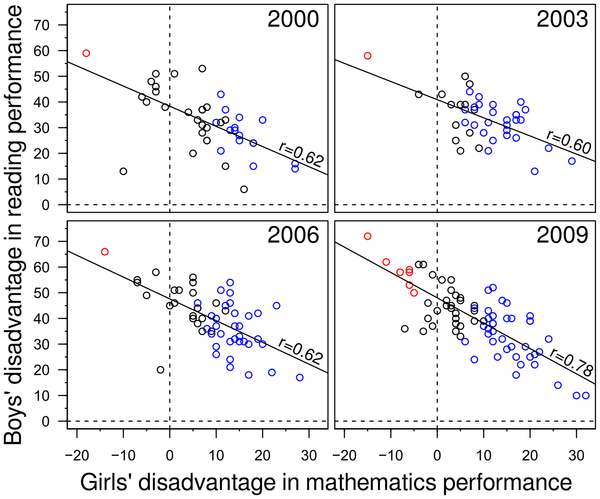It may have taken so long because legacy education methods fight biology and not the persistent claims that there is subtle bias (hidden, stereotype threat and other sociological rationalizations), even in countries with high gender equality. Sex differences in math and reading scores persisted in the 75 nations examined by a University of Missouri and University of Leeds study; girls consistently scored higher in reading, while boys got higher scores in math.
Instead of being gender-based, gaps are linked and vary with overall social and economic conditions of the nation.
“Educational systems could be improved by acknowledging that, in general, boys and girls are different,” said University of Missouri biologist David Geary in their statement. “For example, in trying to close the sex gap in math scores, the reading gap was left behind. Now, our study has found that the difference between girls’ and boys’ reading scores was three times larger than the sex difference in math scores. Girls’ higher scores in reading could lead to advantages in admissions to certain university programs, such as marketing, journalism or literature, and subsequently careers in those fields. Boys lower reading scores could correlate to problems in any career, since reading is essential in most jobs.”
Generally, when conditions are good, the math gap increases and the reading gap decreases and when conditions are bad the math gap decreases and the reading gap increases. This pattern remained consistent within nations as well as among them, according to the work by Geary and Gijsbert Stoet of the University of Leeds that included testing performance data from 1.5 million 15-year-olds in 75 nations.
“In adult life, there are more male CEOs, but also more homeless men,” said Geary. “Boys’ prospects in life seem to react more intensely to positive and negative social conditions, hence we see more variation in boys’ testing scores, especially when conditions are bad.”
The top five percent of scores within nations generally showed girls to be lower in math and boys to be lower in reading. That pattern continued in lower scoring groups until reaching the lowest scoring students, where the math achievement of boys and girls evened out but the reading gap increased, according to Geary.
“The consistent pattern within nations suggests the sex differences are not simply related to socio-economic factors,” said Geary. Socio-economic and cultural factors are important in that they influence the performance of all students, but boys, as a group, respond more strongly than girls, perhaps due to a biological difference in sensitivity to wider conditions.” For example, in nations with impoverished or violent conditions, boys’ scores tended to fall faster and further than girls. On the other hand, in wealthier, socially stable nations boys’ scores benefitted more than girls. This resulted in boys reducing the reading gap and widening the math gap.

Negative correlation between boys’ disadvantage in reading achievement (y-axis) and girls’ disadvantage in mathematics achievement. Each data point indicates the sex differences of one country. Positive values indicate a larger disadvantage, negative values an advantage. Red points indicate nations in which girls’ mathematics achievement is significantly higher than that of boys; blue points indicate nations in which boys’ mathematics achievement is significantly higher than that of girls; and, black points indicate nations in which there is no statistically significant difference in mathematics achievement. The advantage of girls in reading achievement is statistically significant in all nations, except for 2 in 2000 (Israel, Peru) and one in 2003 (Liechtenstein). Credit: doi:10.1371/journal.pone.0057988.g002
“This finding has important implications for how we interpret the math gap of other countries,” said co-author Gijsbert Stoet of the University of Leeds. “For example, policy makers often take Sweden as an example of being particularly good for reducing the gender gap in science, technology, engineering and math, but they do not realize that Swedish boys fall behind in reading more so than in most other highly developed nations. This is a good example of the inverse relation between the math and reading gaps. This phenomenon urgently needs more attention.”
Citation: Stoet G, Geary DC (2013) Sex Differences in Mathematics and Reading Achievement Are Inversely Related: Within- and Across-Nation Assessment of 10 Years of PISA Data. PLoS ONE 8(3): e57988. doi:10.1371/journal.pone.0057988





Comments